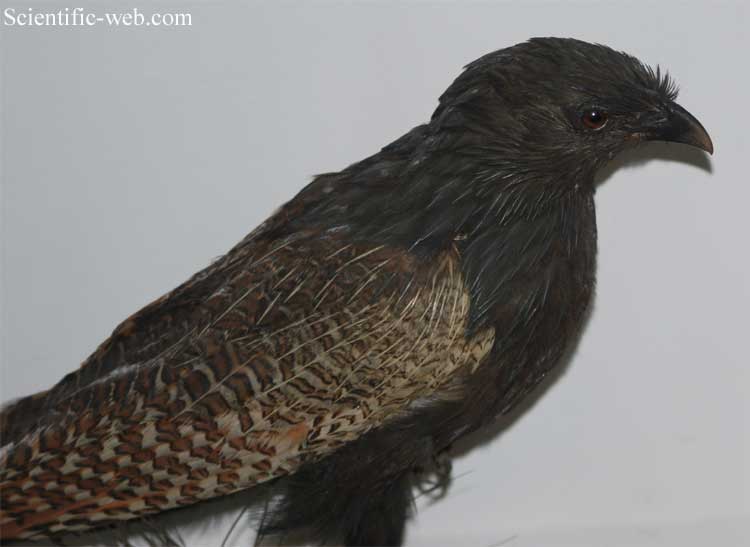
Centropus phasianinus, Photo: Michael Lahanas
Superregnum: Eukaryota
Cladus: Unikonta
Cladus: Opisthokonta
Cladus: Holozoa
Regnum: Animalia
Subregnum: Eumetazoa
Cladus: Bilateria
Cladus: Nephrozoa
Superphylum: Deuterostomia
Phylum: Chordata
Subphylum: Vertebrata
Infraphylum: Gnathostomata
Megaclassis: Osteichthyes
Cladus: Sarcopterygii
Cladus: Rhipidistia
Cladus: Tetrapodomorpha
Cladus: Eotetrapodiformes
Cladus: Elpistostegalia
Superclassis: Tetrapoda
Cladus: Reptiliomorpha
Cladus: Amniota
Classis: Reptilia
Cladus: Eureptilia
Cladus: Romeriida
Subclassis: Diapsida
Cladus: Sauria
Infraclassis: Archosauromorpha
Cladus: Crurotarsi
Divisio: Archosauria
Cladus: Avemetatarsalia
Cladus: Ornithodira
Subtaxon: Dinosauromorpha
Cladus: Dinosauriformes
Cladus: Dracohors
Cladus: Dinosauria
Ordo: Saurischia
Cladus: Eusaurischia
Subordo: Theropoda
Cladus: Neotheropoda
Cladus: Averostra
Cladus: Tetanurae
Cladus: Avetheropoda
Cladus: Coelurosauria
Cladus: Tyrannoraptora
Cladus: Maniraptoromorpha
Cladus: Maniraptoriformes
Cladus: Maniraptora
Cladus: Pennaraptora
Cladus: Paraves
Cladus: Eumaniraptora
Cladus: Avialae
Infraclassis: Aves
Cladus: Euavialae
Cladus: Avebrevicauda
Cladus: Pygostylia
Cladus: Ornithothoraces
Cladus: Ornithuromorpha
Cladus: Carinatae
Parvclassis: Neornithes
Cohors: Neognathae
Cladus: Neoaves
Ordo: Cuculiformes
Familia: Cuculidae
Genus: Centropus
Species: Centropus phasianinus
Subspecies: C. p. melanurus - C. p. mui - C. p. nigricans - C. p. obscuratus - C. p. phasianinus - C. p. propinquus - C. p. spilopterus - C. p. thierfelderi
Name
Centropus phasianinus (Latham, 1802)
Cuculus phasianus (protonym)
References
Supplementum indicis ornithologici p.xxx
Vernacular names
čeština: Kukačka bažantí
English: Pheasant Coucal
español: Cucal faisán
Nederlands: Fazantspoorkoekoek
Türkçe: Sülün kukalı
The pheasant coucal (Centropus phasianinus) is a species of cuckoo in the family Cuculidae. It is found in Australia, Timor and New Guinea. Its natural habitats are subtropical or tropical moist lowland forests and subtropical or tropical mangrove forests. It has adapted well to canefields in northern Australia.[2] The pheasant coucal is unusual among Australian cuckoos in that it incubates and raises its own young instead of laying its eggs in the nest of another species.
Taxonomy
The ornithologist John Latham described the pheasant coucal as Cuculus phasianinus in 1801, based on a drawing by Thomas Watling.[3] Six subspecies are recognised, two of which are found in Australia with an abrupt demarcation between them occurring around the Burdekin River in Central Queensland. South is the nominate subspecies phasianinus, while north is the subspecies melanurus, which is larger in size and has darker and more prominent black bands on its rectrices. The little known subspecies mui is found in eastern Timor, and has distinctive white plumage of its upperparts, head and breast. The remaining three subspecies are found in New Guinea, and all have darker plumage than other forms. Subspecies thierfelderi is found in the Trans-fly region in the south of the island and is intermediate between melanurus and nigricans. Subspecies nigricans occurs in the eastern coastal regions of New Guinea and the D'Entrecasteaux Islands. Propinquus is a smaller subspecies from northern New Guinea.[4]
The Kai coucal (C. spilopterus) of the Kai Islands in Indonesia was formerly considered conspecific, but was split as a distinct species by the IOC in 2021.[5]
Description
50 to 70 cm (20 to 28 in) in length, the pheasant coucal is a large heavy-set bird adapted for living on the ground, reminiscent of a pheasant in shape. Birds in breeding plumage have black heads, necks, breasts and bellies, barred chestnut wings and long black, brown and cream barred tails. Outside the breeding season, their black head and underparts moult to a white-streaked chestnut colour.[6]
The pheasant coucal's summer voice is a low descending 'boop boop boop'. Its winter voice is a sharp hissing.[7]
Distribution and habitat
In Cape York, Queensland
It is found in eastern and northern Australia, from the New South Wales south coast north to Cape York, and across the top of Australia to the Pilbara, as well as eastern Timor and lowland New Guinea.[4] The preferred habitat has dense understory as a component, typically shrubby understory in forest, or tall grasses in grassland or swampy areas, as well as sugar cane in cane plantations and patches of weedy vegetation such as blackberry or lantana.[6]
Feeding
Predominantly carnivorous, the pheasant coucal eats small reptiles and amphibians, bird eggs and young, small mammals and large insects.[6]
Breeding
The nest is an untidy bowl-shaped structure made of grasses and leaves. It is located in tall grass or bushes, and the stems overhead are often tied together to make a canopy. Two to five white oval eggs measuring 38 by 29 mm are laid.[8] The incubation period is 15 days, with young remaining in the nest for another 13 days.[6] The male pheasant coucal does most of the incubating of eggs and feeding of young, as well as building the nest.[9]
References
BirdLife International (2016). "Centropus phasianinus". IUCN Red List of Threatened Species. 2016: e.T22684209A93018702. doi:10.2305/IUCN.UK.2016-3.RLTS.T22684209A93018702.en. Retrieved 13 November 2021.
Blakers et al. (1984). The Atlas of Australian Birds, Carlton: Melbourne University Press. ISBN 0-522-84285-2
Department of the Environment, Water, Heritage and the Arts (12 December 2008). "Subspecies Centropus (Polophilus) phasianinus phasianinus (Latham, 1801)". Australian Government. Retrieved 13 July 2012.
Mason, I. J.; McKean, J. L.; Dudzinski, M. L. (1984). "Geographical variation in the Pheasant Coucal Centropus phasianinus (Latham) and a description of a new subspecies from Timor". Emu. 84: 1–15. doi:10.1071/MU9840001.
"Species Updates – IOC World Bird List". Retrieved 2021-06-13.
"Pheasant Coucal". Australian Museum - Birds in Backyards. Retrieved 12 July 2012.
Simpson & Day (1999). Field Guide to the Birds of Australia, Ringwood: Penguin Books Australia. ISBN 0-670-87918-5
Beruldsen, Gordon (2003). Australian Birds: Their Nests and Eggs. Kenmore Hills, Qld: self. p. 260. ISBN 0-646-42798-9.
Maurer, Golo (2008). "Who Cares? Males Provide Most Parental Care in a Monogamous Nesting Cuckoo". Ethology. 114 (6): 540–547. doi:10.1111/j.1439-0310.2008.01498.x.
Retrieved from "http://en.wikipedia.org/"
All text is available under the terms of the GNU Free Documentation License

